The Apple iPad Air 2 Review
by Joshua Ho on November 7, 2014 9:30 AM EST- Posted in
- Tablets
- Apple
- Mobile
- iOS
- ipad Air 2
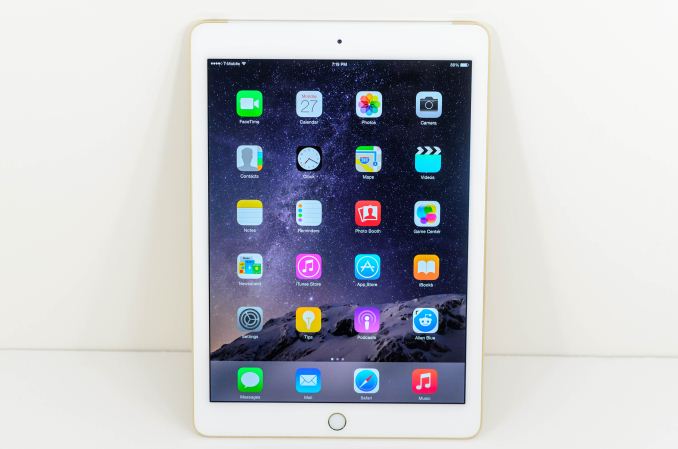
As we approach the holidays, Apple has launched a new iPad as expected. As one might expect from the name, the iPad Air 2 is more of an evolution of the original iPad Air than a clean-sheet design. This doesn’t mean that there’s little to talk about though, as Apple has gone a long way to improve every aspect of the iPad Air with this iteration. However, with this generation Apple seems to be under fire as Google attempts to push into the premium tablet space with the Nexus 9.
Without question though, the iPad line defines what an ARM-based tablet is. The iPad Air 2 is undoubtedly a part of this lineage with its focus on a large touch-screen display. This level of design minimalism is responsible for at least part of the original reaction to the tablet as a “large phone”. However, by virtue of its sheer size there are new possibilities opened up in terms of content consumption and even content creation. In the basic definition of a tablet, the iPad Air 2 definitely fits. There’s a new SoC, more RAM, a better display lens, new cameras, and an even thinner design, but all of these things don’t change the fact that this is a 9.7” display that can only be interacted with through a touchscreen. In the interest of saving space and time, I’ve included a spec sheet below to cover all bases.
| Apple iPad Air 2 | |
| SoC | 3x 1.5 GHz CPU A8X |
| RAM/NAND | 2GB LPDDR3 + 16/64/128GB NAND |
| Display | 9.7" 2048x1536 IPS LCD |
| Network | WiFi only or 2G / 3G / 4G LTE SKU |
| Dimensions | 240 x 169.5 x 6.1 mm, 437g WiFi, 444g LTE |
| Camera | 8MP Rear Facing with F/2.4 aperture, 1.3MP FFC |
| Battery | 7340 mAh (27.62 Whr) |
| OS | iOS 8.x |
| Connectivity | 802.11a/b/g/n/ac + BT 4.1, USB2.0, GPS/GNSS |
As with any other mobile device, one of the most immediate impressions one can form is that of design. This may be one of the most important areas as well, because every mobile device is constantly held or otherwise handled. These devices tend to be deeply personal as well, which means that there’s a great deal more emphasis on industrial design than a desktop tower that gets shoved into a dark corner for five years at a time.
To this end, the iPad Air 2 does quite well. The design is definitely separate from the iPhone 6 line, as the metal chamfer remains, but the form continues to be quite pleasing. On the front face of the tablet, we see a single 1.2MP camera, the display, and the home button which has TouchID built in. The glass is flat, which makes it seem noticeably different from the iPhone 6 line in that regard as it meets the chamfered edge of the back cover rather than making a seamless curve. The radius of the curve is also noticeably different as a result, simply curving in towards the center of the device rather than curving out of the device. If anything, this does make the iPad Air 2 feel a bit thicker in the fingers but the device overall is still incredibly thin.
Speaking of the back cover, there’s really almost nothing to speak of on the back cover. There’s the 8MP camera and a microphone hole, but not much else other than the large plastic RF window on the top edge of the tablet. The curve of the sides does make it seem like there’s a great deal more on the back cover though. Other than the RF window, there’s a power button and 3.5mm jack on the top of the tablet. Next to the power button are the volume buttons, but curiously no mute/lock rotation switch for this generation. I suspect that the reasons for this deletion are primarily due to user confusion, although my experiences are purely anecdotal in this regard. Finally, along the bottom of the device we see the Lightning port and two speaker grilles.
Overall, the design of the iPad Air 2 is impressive. The thin feel is really quite impressive when compared against other devices, but the weight no longer feels quite as incredible as the original iPad Air when compared to the iPad 4.
Outside of the physical design, Apple has also included a selection of two cases which include the smart cover and case, which are mostly unchanged from the previous generation except to fit the iPad Air 2. I don’t have much to complain about here although the smart case has a bit more flex on the sides than I’d like. The smart cover does have enough strength in the magnets to hold the tablet by the cover, although I wouldn't recommend doing this.


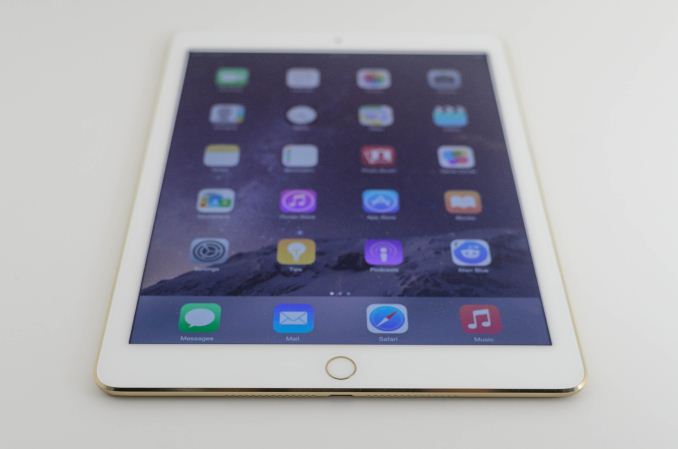
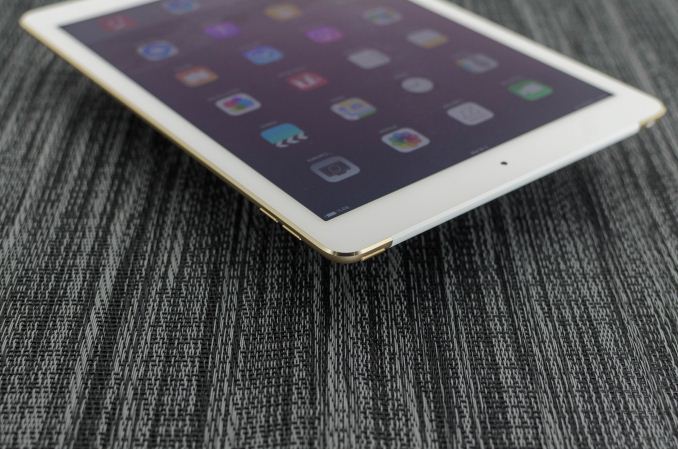
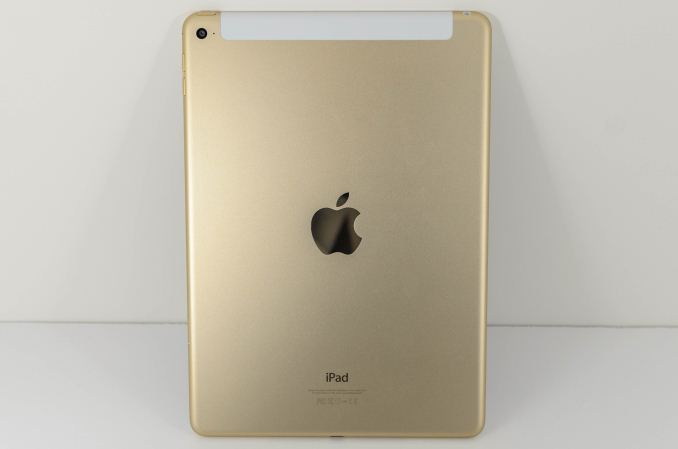

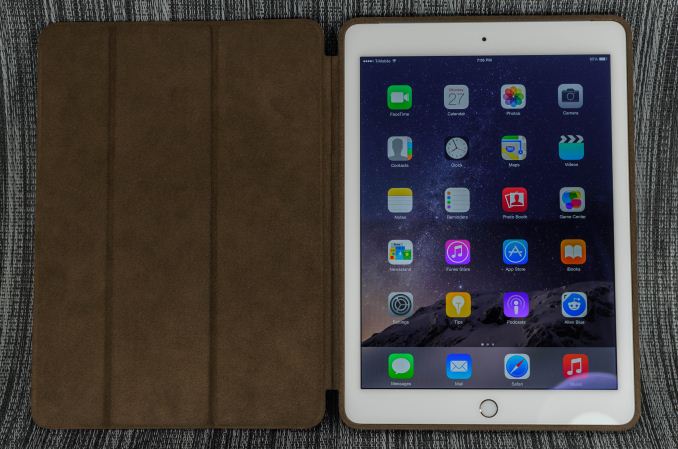








226 Comments
View All Comments
Speedfriend - Friday, November 7, 2014 - link
When I read about the A8, it make me wonder about the A7. With the A8 Apple claims to have improved energy efficiency over the A7 by 50%. Now a iPhone 6 Plus driving a 1920x1020 screen has the same 10 hour battery life as a Galaxy Note 3 which also has a 1920 x 1080 screen. But that means that if Apple had tried to build a phablet with the A7, they would have ended up with a battery life of around 6.5 hours, clearly not competitive with Samsung’s offerings.So to me it looks like Apple didn’t build a bigger screen phone before not because they didn’t feel there was demand but because they simply wouldn’t have been able to compete on battery life and that is why the whole focus with the A8 was improving efficiency rather than simply performance.
So was the A7 just very uncompetitive to other ARM designs or is iOS inefficient compared to Android.
I would love to see someone do some digging on this – Anandtech?
dmunsie - Friday, November 7, 2014 - link
I don't think this has anything to do with either the A7 design or iOS -- there are too many variables in the equation to definitively say. Plus unlike other ARM designs and Android, there is only one source for the A7 and iOS -- Apple. So you can't just take iOS and install it on the same hardware as another Android device and compare.The A7 was also used in the iPad and iPad mini last year where it got an advertised 10 hour battery life. If Apple had made a Plus sized iPhone last year, they probably would've had to make it thicker to get to their target battery life, which is probably similar to what Samsung has done with their designs. Apple never likes to go thicker if they can avoid it.
You can see how Apple values size over battery life because with the move to the A8X, the Air 2 got thinner with the same battery life vs staying the same size but with more battery life. Not saying that valuing battery live over size is better than what Apple chose, but they are clearly making it known what they are optimizing for here.
Impulses - Friday, November 7, 2014 - link
As an Android fan, I'd love to see Apple stop chasing thinness and actually improve battery life by a large degree... They could've done so with the iPhone 6 and chased the claim of "2 day battery life", but they chose thinness instead.Having Apple claiming two day battery life on a phone and destroying everything else by a large margin would definitely light a fire under everyone... Over engineering for 7mm thickness vs 8.5 mm seems quite pointless to me, anything under 9 is quite enough on a phone.
It seems structurally speaking they're better off to, e.g. bendgate...
sonicmerlin - Friday, November 7, 2014 - link
Personally I'd like my phone to be as thin as a credit card.akdj - Thursday, November 27, 2014 - link
Be state came and went in ten minutes. It's a non issueMight check those up times on the 6+ again. They reflect almost identical performance as mine. I could go two days, easily.
Speedfriend - Monday, November 10, 2014 - link
Except the note and the iPhone 6+ have the same size battery, so samsung hasn't had to use a bigger battery to get the same battery life.techconc - Friday, November 7, 2014 - link
You "analysis" fails to consider the size of the battery in existing devices as part of the equation. Likewise, your conclusion regarding the A7 design not being competitive is completely baseless. What's more, you also fail to consider the manufacturing process as a variable as well. The primary efficiency difference between the A8 and A7 has much more to do with the manufacturing process moving from 28nm to 20nm.Finally, if you wish to compare Apple's chips with the competition or iOS vs. Android in terms of efficiency, you should ask yourself why Android phones require more memory to perform the same tasks and why Android devices need such a bigger battery in order to get the same level of usage and/or performance.
Speedfriend - Monday, November 10, 2014 - link
At techconcBattery size is almost identical. Manufacturing process has absolutey nothing to do with it. Or the efficiency difference between A8 and A7. It is a fairly simply equation - at same battery size, A8 equipe diPhone 6+ gives smae battery life as Note 3/4. Swap out A8 for A7 and you would get 1/3 less battery life based on Apple's 50% A8 over A7 efficiency claim. Hence why no big iPhone before.
tipoo - Friday, November 7, 2014 - link
Yup, when I saw the teardown with two RAM banks rather than the usual one, I was expecting 25.6GB/sec, with double the pins/bits going into the SoC. And it also makes sense with the huge GPU gains, something has to feed that beast. Crazy, that's now in laptop bandwidth range.cynic783 - Friday, November 7, 2014 - link
and we made it about 10 comments before the "Anand is an Apple shill" accusation lol. so much Android butt hurt.